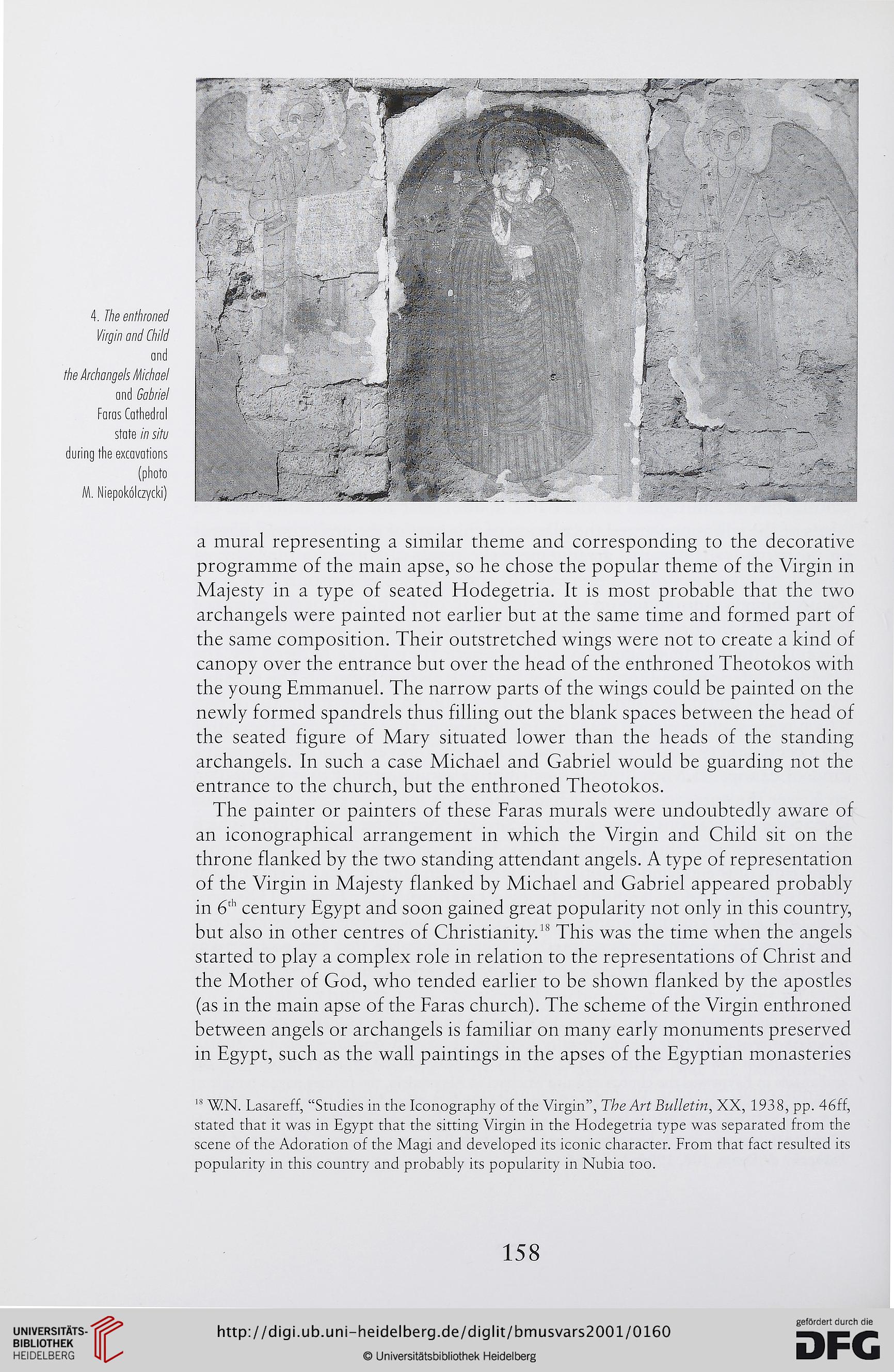4. The enthroned
Virgin and Child
and
the Archongels Michael
and Gabriel
Faras Cathedral
State in situ
during the excavations
(photo
M. Niepokólczycki)
a mural representing a similar theme and corresponding to the decorative
programme of the main apse, so he chose the popular theme of the Virgin in
Majesty in a type of seated Hodegetria. It is most probable that the two
archangels were painted not earlier but at the same time and formed part of
the same composition. Their outstretched wings were not to create a kind of
canopy over the entrance but over the head of the enthroned Theotokos with
the young Emmanuel. The narrow parts of the wings could be painted on the
newly formed spandrels thus filling out the blank spaces between the head of
the seated figurę of Mary situated lower than the heads of the standing
archangels. In such a case Michael and Gabriel would be guarding not the
entrance to the church, but the enthroned Theotokos.
The painter or painters of these Faras murals were undoubtedly aware of
an iconographical arrangement in which the Virgin and Child sit on the
throne flanked by the two standing attendant angels. A type of representation
of the Virgin in Majesty flanked by Michael and Gabriel appeared probably
in 6th century Egypt and soon gained great popularity not only in this country,
but also in other centres of Christianity.18 This was the time when the angels
started to play a complex role in relation to the representations of Christ and
the Mother of God, who tended earlier to be shown flanked by the apostles
(as in the main apse of the Faras church). The scheme of the Virgin enthroned
between angels or archangels is familiar on many early monuments preserved
in Egypt, such as the wali paintings in the apses of the Egyptian monasteries
18 WN. Lasareff, “Studies in the Iconography of the Virgin”, The Art Bulletin, XX, 1938, pp. 46ff,
stated that it was in Egypt that the sitting Virgin in the Hodegetria type was separated from the
scene of the Adoration of the Magi and developed its iconic character. From that fact resulted its
popularity in this country and probably its popularity in Nubia too.
158
Virgin and Child
and
the Archongels Michael
and Gabriel
Faras Cathedral
State in situ
during the excavations
(photo
M. Niepokólczycki)
a mural representing a similar theme and corresponding to the decorative
programme of the main apse, so he chose the popular theme of the Virgin in
Majesty in a type of seated Hodegetria. It is most probable that the two
archangels were painted not earlier but at the same time and formed part of
the same composition. Their outstretched wings were not to create a kind of
canopy over the entrance but over the head of the enthroned Theotokos with
the young Emmanuel. The narrow parts of the wings could be painted on the
newly formed spandrels thus filling out the blank spaces between the head of
the seated figurę of Mary situated lower than the heads of the standing
archangels. In such a case Michael and Gabriel would be guarding not the
entrance to the church, but the enthroned Theotokos.
The painter or painters of these Faras murals were undoubtedly aware of
an iconographical arrangement in which the Virgin and Child sit on the
throne flanked by the two standing attendant angels. A type of representation
of the Virgin in Majesty flanked by Michael and Gabriel appeared probably
in 6th century Egypt and soon gained great popularity not only in this country,
but also in other centres of Christianity.18 This was the time when the angels
started to play a complex role in relation to the representations of Christ and
the Mother of God, who tended earlier to be shown flanked by the apostles
(as in the main apse of the Faras church). The scheme of the Virgin enthroned
between angels or archangels is familiar on many early monuments preserved
in Egypt, such as the wali paintings in the apses of the Egyptian monasteries
18 WN. Lasareff, “Studies in the Iconography of the Virgin”, The Art Bulletin, XX, 1938, pp. 46ff,
stated that it was in Egypt that the sitting Virgin in the Hodegetria type was separated from the
scene of the Adoration of the Magi and developed its iconic character. From that fact resulted its
popularity in this country and probably its popularity in Nubia too.
158




